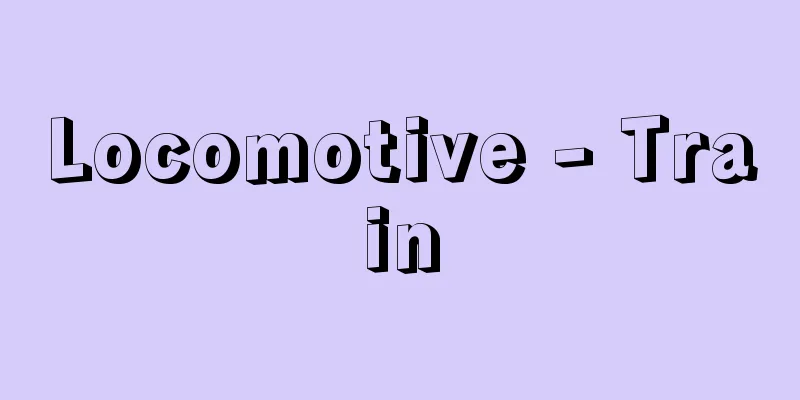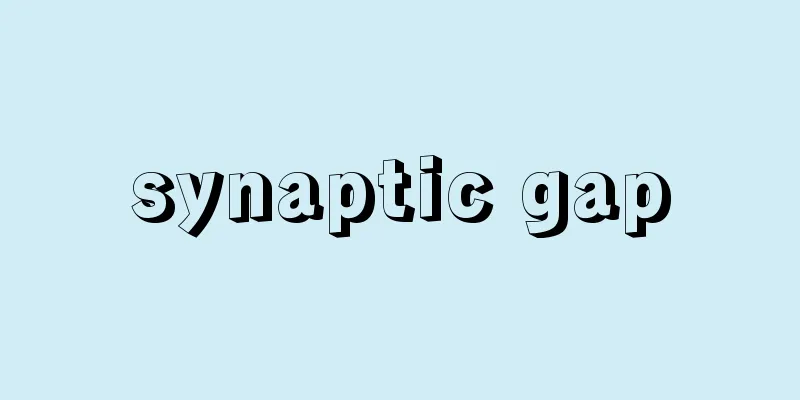Locomotive - Train

|
A rail vehicle used to pull passenger cars, freight cars, etc., that is equipped with a self-propelled engine and has no facilities for carrying passengers, freight, etc. Depending on the type of engine, there are steam locomotives (tender locomotives, tank locomotives), electric locomotives (DC locomotives, AC locomotives, AC/DC locomotives), diesel locomotives (mechanical locomotives, electric locomotives, hydraulic locomotives), special locomotives (fireless locomotives, turbine (steam, gas) locomotives), etc. Depending on the purpose, locomotives are divided into passenger, freight, passenger/freight, switching, gradient, etc. Also, depending on the type of train, they may be divided into express trains, local trains, and depending on the type of track, main line, branch line, etc. [Shoji Matsuzawa] History and types of locomotivesIn the early days of railways, the only power source that could be used was steam, and it was difficult to mechanically make steam-powered engines small enough to be mounted under the floor or in part of the interior of passenger and freight cars. As a result, the basic system was that a locomotive, which was a vehicle with only a power unit, pulled passenger and freight cars as trailers. (1) Steam locomotives Steam locomotives, which use steam as a power source, have the longest history for the reasons mentioned above. In 1804, Trevithick of England built the first locomotive that ran on rails. Next, George Stephenson, also of England, built a full-scale locomotive and successfully operated it in 1814. In 1825, he built the Locomotion, which was used on the world's first commercial railway between Stockton and Darlington. Furthermore, in 1829, Stephenson and his son Robert built the Rocket, which won a locomotive competition to be used on the railway between Liverpool and Manchester, also in the UK. In terms of basic theory, the Rocket is no different from modern steam locomotives, and this reciprocating engine design has been followed and improved in countries all over the world, becoming the driving force behind the development of railways. Japan's steam locomotives began in 1872 (Meiji 5) when 10 tank locomotives were imported from England along with railway technology prior to the opening of the Shinbashi (later Shiodome Station, closed in 1986) to Yokohama (present-day Sakuragicho Station) line. One of these, numbered Locomotive No. 1, was designated a railway monument in 1958 (Showa 33) and an Important Cultural Property of Japan in 1997 (Heisei 9). It is currently preserved and exhibited at the Railway Museum in Saitama City, Saitama Prefecture. Locomotive No. 3 (Class 110 steam locomotive) has also been designated a railway monument and is preserved and exhibited at Ome Railway Park in Tokyo. Since the Japanese National Railways (now JR) completely phased out steam locomotives in March 1976 (Showa 51), steam locomotives have generally not been in commercial operation, although there have been exceptional runs for tourists. (2) Electric locomotives The first electric locomotive was a small direct current electric locomotive unveiled by the German Siemens at the Berlin Industrial Exposition held in 1879, about 70 years after the steam locomotive, which pulled a carriage carrying 18 spectators. In 1880, American Thomas Edison also produced an electric locomotive. Since then, electric locomotives have been developed in Germany, Switzerland and other countries, and continue to this day. The first electric locomotive in Japan was a small 10000 series (EC40 series) imported from Germany, which was used on the Abt system railway section of the Shinetsu Line between Yokokawa and Karuizawa at Usui Pass in 1912 (Meiji 45). This locomotive is preserved as a railway monument at the (former) Karuizawa Station Memorial Museum at Karuizawa Station. Full-scale use on flat tracks began in 1925 (Taisho 14) on the Tokaido Main Line between Tokyo and Kozu and Tokyo and Yokosuka, using locomotives imported from the UK and the US. (3) Diesel locomotives These are the main internal combustion engines, and although there are gasoline locomotives, they are hardly used nowadays. Diesel locomotives were manufactured in Germany in 1912, but they started to be used as full-scale locomotives in the United States around 1940. There are three types of diesel locomotives: mechanical, in which the rotation of the diesel engine is directly used to drive the vehicle by converting the speed using a gear transmission; electric, in which the diesel engine turns a generator and the electricity generated is used to drive a motor; and hydraulic, in which the rotation of the diesel engine is transmitted to the axles via a hydraulic transmission to drive the axles. Japan's diesel locomotives began with the acquisition of electric DC11 and mechanical DC10 locomotives from Germany as reparations in 1929 and 1930. Neither was suited to the national conditions, so the small DB10 was manufactured in 1932, and the DD10 for main lines in 1935, but production was discontinued due to the lack of fuel available during the war. After World War II, the electric DD50 was manufactured in 1953, followed by the DF50 in 1957. Later, as the development of hydraulic transmissions progressed, the small DD13 and the large DD51 were manufactured, and hydraulic transmissions are now mostly used. There are also locomotives with gas turbine and jet engines, but they are so few in number that they are more appropriately treated as special locomotives. [Shoji Matsuzawa] Comparison of locomotivesSteam locomotives, electric locomotives, and diesel locomotives each have their own advantages and disadvantages based on their power source and structure. For over 100 years since the founding of railroads, steam locomotives were the main locomotives. Despite their fuel efficiency of only 5-7%, they were used because they had the following advantages: maximum tractive force at low speeds, easy speed control, the ability to withstand temporary harsh use, a relatively simple structure, and little risk of breakdown. However, they had disadvantages, such as low efficiency, the soot they produced made crew and passengers uncomfortable, and they required a lot of maintenance. To improve efficiency, research was conducted into changing the steam engine system to turbine, high-pressure, and compound, but the structure became more complex despite the increased efficiency, and they ended up giving way to electric and diesel locomotives. Electric locomotives have the advantage of being highly efficient at about 30%, and because they receive electricity for their power source from overhead lines, etc., they have the advantage of having a large output per unit weight of the locomotive. However, they require considerable expenses for the substation equipment and power supply equipment required for electric operation, so they are not profitable unless the line has a high traffic density. Diesel locomotives use the most efficient diesel engine among internal combustion engines, so their efficiency is 20-25%, which is slightly lower than that of electric locomotives, but they do not require ground facilities like electric locomotives, so they can easily replace steam locomotives. However, they have the disadvantage that their mechanism is somewhat complicated and the engine output cannot be pushed as hard as that of steam locomotives. Taking into account the above three characteristics, the locomotives that are appropriate for the age of modernization of power sources and energy conservation are electrified electric locomotives on sections with high traffic density, and diesel locomotives on other less busy sections. [Shoji Matsuzawa] "Railway Dictionary, Volumes 1 and 2, edited by Japan National Railways (1958, Transportation Cooperation Association)" ▽ "Latest Railway Vehicle Engineering, by Kubota Hiroshi (1968, Koyusha)" ▽ "Universal Guide Series 25, Locomotives, Electric and Diesel, by Miyazawa Koichi and Seki Takahiro (1983, Shogakukan)" ▽ "The Rise and Fall of the Steam Locomotive, by Saito Akira (1996, NTT Publishing)" ▽ "The Challenge of the Steam Locomotive, by Saito Akira (1998, NTT Publishing)" ▽ "Railway Vehicle Handbook, by Kubota Hiroshi (1997, Grand Prix Publishing)" ▽ "Illustrated Complete History of Electric Locomotives, From Imported Electric Locomotives of the Meiji and Taisho Periods to JR Freight's New Generation Electric Locomotives" (2004, Gakken)" ▽ "The Story of the Birth of the Steam Locomotive, by Mizushima Tohoru (2004, Grand Prix Publishing)" ▽ "30 Years of Private Railway Locomotives - A Record of 30 Years of Private Railway Locomotives with Photographs and Explanations of All Types of Locomotives, a Dramatic Decline" by Yuichi Terada (2005, JTB Publishing) [References] | | | | | | | | | |©Toshihisa Watanabe "> Structure of a steam locomotive (C62 type) ©Toshihisa Watanabe "> Structure of electric locomotive (EF66 type) ©Toshihisa Watanabe "> Structure of diesel locomotive (DD51 type) Source: Shogakukan Encyclopedia Nipponica About Encyclopedia Nipponica Information | Legend |
|
客車、貨車などを牽引(けんいん)するための鉄道車両で、自走できる原動機を備え、旅客、貨物などを積載する設備をもたないもの。 原動機の種類によって、蒸気機関車(テンダー機関車、タンク機関車)、電気機関車(直流機関車、交流機関車、交直流機関車)、ディーゼル機関車(機械式機関車、電気式機関車、液体式機関車)、特殊機関車(無火機関車、タービン(蒸気、ガス)機関車)などがある。用途別では、旅客用、貨物用、客貨用、入れ換え用、勾配(こうばい)用などに分けられ、また、列車の種類によって急行列車用、普通列車用、さらに、線路の種別によって本線用、支線用などに分けられる場合がある。 [松澤正二] 機関車の歴史と種類鉄道の創設期に採用できた動力源は蒸気しかなく、しかも蒸気動力機関は、客貨車の床下や室内の一部に搭載できるような小型のものは機構上困難であったので、動力装置のみの車両である機関車が、トレーラーとしての客車や貨車を牽引する方式が基本であった。 (1)蒸気機関車 蒸気を動力源とする蒸気機関車は、前述の理由から歴史がもっとも古く、1804年にイギリスのトレビシックが、初めてレールの上を走る機関車を製作した。次に同じイギリスのジョージ・スティーブンソンは、本格的な機関車を製作して1814年に運転に成功、さらに1825年、ストックトン―ダーリントン間の世界最初の営業用鉄道に使われたロコモーション号を製作した。さらにスティーブンソンと息子のロバートは1829年には、同じイギリスのリバプール―マンチェスター間の鉄道に使う機関車のコンテストに優勝したロケット号を製作した。このロケット号は、基本的な理論においては現在の蒸気機関車となんら変わることがなく、この往復運動機関式の設計が世界各国で踏襲され、改良が加えられ、鉄道の発展の原動力となった。 日本の蒸気機関車の始まりは、1872年(明治5)の新橋(のちの汐留(しおどめ)駅、1986年廃止)と横浜(現桜木町駅)間の開業に先だち、鉄道の技術とともにイギリスから輸入したタンク機関車10両である。そのうちの1号の番号がつけられた機関車(一号機関車)は、1958年(昭和33)に鉄道記念物、1997年(平成9)に国の重要文化財に指定された。現在は埼玉県さいたま市の鉄道博物館に保存展示されている。また、三号機関車(110形蒸気機関車)も鉄道記念物に指定されており、東京の青梅鉄道公園(おうめてつどうこうえん)に保存展示されている。1976年(昭和51)3月、国鉄(現JR)が蒸気機関車を全廃して以来、観光客を対象とした例外的な運転はあるものの、基本的に蒸気機関車の営業運転は行われていない。 (2)電気機関車 蒸気機関車に遅れること約70年、1879年に開催されたベルリン勧業博覧会場において、ドイツ人のジーメンスが発表した小型の直流電気機関車で、18人の観覧者を乗せた車両を引いたのが最初である。1880年にはアメリカのエジソンも電気機関車を製作した。以後はドイツ、スイスなどで発達し今日に至っている。 日本の電気機関車の始まりは、1912年(明治45)に信越線の横川―軽井沢間の碓氷(うすい)峠用のアプト式鉄道区間に採用したもので、ドイツから輸入した小型の10000形(EC40形)である。この機関車は鉄道記念物として軽井沢駅の(旧)軽井沢駅舎記念館に保存されている。平坦(へいたん)線での本格的な使用は、1925年(大正14)に東海道本線の東京―国府津(こうづ)間および東京―横須賀間で、イギリスとアメリカから輸入した機関車である。 (3)ディーゼル機関車 内燃機関車の主力をなすもので、ほかにガソリン機関車があるが、現在はほとんど使われていない。ディーゼル機関車は1912年にドイツで製作されたが、本格的な機関車として活躍し始めたのはアメリカで、1940年ごろのことである。 ディーゼル機関車には、ディーゼル機関の回転を直接、歯車式変速機によって速度を変換して駆動する機械式と、ディーゼルエンジンで発電機を回し、発生する電力でモーターを駆動する電気式と、ディーゼル機関の回転を、液体変速機を介して車軸に伝えて駆動する液体式の3方式がある。 日本のディーゼル機関車の始まりは、1929年(昭和4)と1930年にドイツから、DC11形の電気式とDC10形の機械式の機関車を賠償として入手したものである。ともに国情にあわず、1932年に小型のDB10形を、1935年に本線用のDD10形を製作したが、戦争のため燃料が入手難となり中止された。第二次世界大戦後の1953年(昭和28)に電気式のDD50形が、続いて1957年にDF50形が製作された。その後、液体変速機の開発が進むとともに、小型のDD13形、大型のDD51形が製作され、現在はほとんど液体式が使用されている。また、ガスタービン機関やジェット機関をもった機関車もあるが、特殊機関車として扱うのが適切なくらい少数である。 [松澤正二] 各機関車の比較蒸気機関車、電気機関車、ディーゼル機関車には、その動力源および構造上それぞれの長所と短所がある。 鉄道創業時から約100年余りにわたって、蒸気機関車は主力機関車であった。燃料効率がわずか5~7%でありながら使用されていた理由は、低速時に最大牽引力を発揮すること、速度制御が容易にできること、一時的に過酷な使用にも耐えること、構造が比較的簡単で、故障しにくいなどの利点があったためである。しかし、低効率と、煤煙(ばいえん)により乗務員や乗客が不快となり、保守に手がかかることなどの欠点がある。効率の向上を図るため、蒸気機関の方式をタービン式、高圧式、複式等にする研究がなされたが、効率向上のわりに構造が複雑となり、結果としては電気機関車、ディーゼル機関車に活躍の場を譲ることになった。 電気機関車は、効率が約30%と高く、動力源の電気を架線等から受けるため、機関車重量当りの出力が大きい利点がある。しかし、電気運転のための変電設備、給電設備等に相当な経費を必要とするので、輸送密度の高い線区でないと採算性がよくない。 ディーゼル機関車は、内燃機関車のうちではもっとも効率が高いディーゼル機関を使用しているため、効率は20~25%で、電気機関車に比較してやや低いが、電気機関車のような地上設備が不要なので、蒸気機関車の代替をすることが容易である。しかし、機構がやや複雑で、エンジンの出力は蒸気機関車のような無理がきかない欠点もある。 以上、三者の特性により、動力近代化と省エネルギー時代に即する機関車としては、輸送密度の高い線区は電化により電気機関車が、他の閑散線区においてはディーゼル機関車の使用が適切である。 [松澤正二] 『日本国有鉄道編『鉄道辞典』上下(1958・財団法人交通協力会)』▽『久保田博著『最新鉄道車両工学』(1968・交友社)』▽『宮沢孝一・関崇博著『万有ガイド・シリーズ25 機関車 電気・ディーゼル』(1983・小学館)』▽『斎藤晃著『蒸気機関車の興亡』(1996・NTT出版)』▽『斎藤晃著『蒸気機関車の挑戦』(1998・NTT出版)』▽『久保田博著『鉄道車両ハンドブック』(1997・グランプリ出版)』▽『『「図説」電気機関車全史 明治・大正期の輸入電機からJR貨物の新世代電機まで』(2004・学習研究社)』▽『水島とほる著『蒸気機関車誕生物語』(2004・グランプリ出版)』▽『寺田裕一著『私鉄機関車30年――激減した私鉄の機関車・全形式写真と解説で30年間を記録』(2005・JTBパブリッシング)』 [参照項目] | | | | | | | | | |©渡部利久"> 蒸気機関車の構造(C62形) ©渡部利久"> 電気機関車の構造(EF66形) ©渡部利久"> ディーゼル機関車の構造(DD51形) 出典 小学館 日本大百科全書(ニッポニカ)日本大百科全書(ニッポニカ)について 情報 | 凡例 |
Recommend
Overkill
It is translated as "excessive genocide."...
Lidocaine hydrochloride
...White to pale yellow crystals or crystalline p...
Liver soup - Kimosui
It is used to mean that the liver is used as the ...
martyrdom
…In the Buddhist cultural sphere, the idea of b...
Fermi energy
…Electrons fill these k states in order from lowe...
Azuki bean weevil - Azuki zoomushi (English spelling) Chinese seed beetle
An insect belonging to the family Bruchidae in th...
Boundary Friction
Friction that occurs when the contact surfaces of ...
The sad story of a factory girl
This is a record of the realities of female facto...
Catheterization - Dounyo
〘 noun 〙 A catheter is inserted into the bladder t...
Records room
…It is currently in the collection of the Pierpon...
Ichiyousei - Ichiyousei
...It also means the arrival of spring or the end...
Foreign Investment Review Act
...This was realized as a policy under the Pierre...
Orbit - Kido
〘noun〙① The path of an object or particle that mov...
Noheji [town] - Noheji
A town on the southeast coast of Mutsu Bay in Kami...
Glory Story (Eiga Monogatari) - Movie Story
This historical tale is written in kana in the sty...









